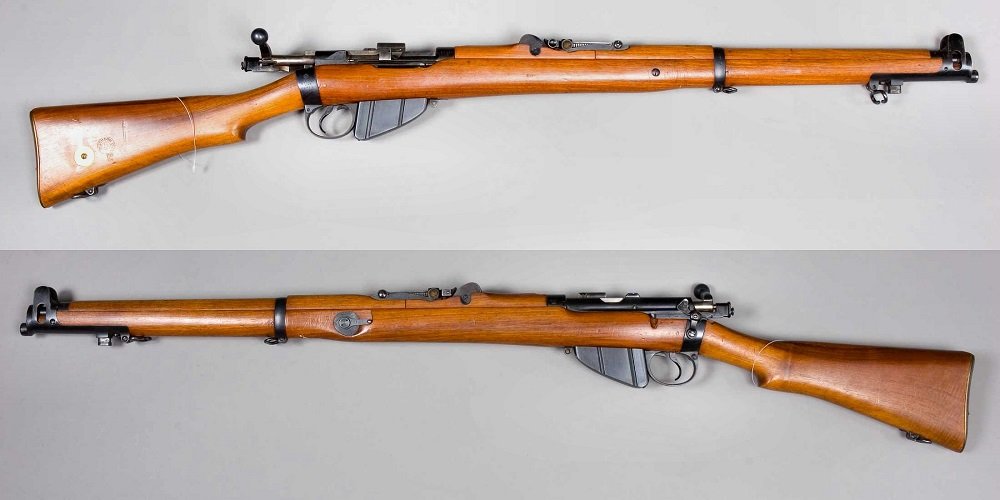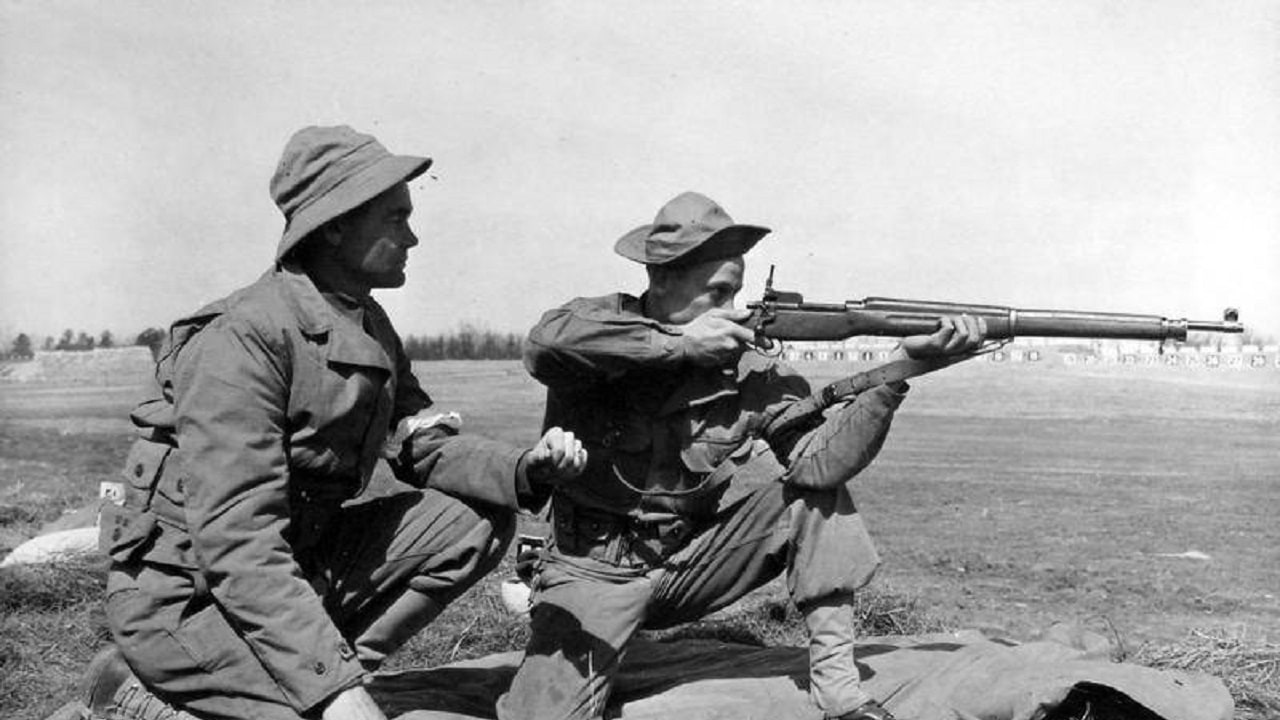What made the Lee-Enfield special: As I noted in a separate 19FortyFive article on the Japanese Arisaka rifles, during the Second World War, the United States became the first nation to adopt a semiautomatic battle rifle for general issue to her troops – namely the M1 Garand, which General Patton lauded as “the greatest battle implement ever devised” – whilst other Allied nations and the Axis powers alike were content to stick with bolt-action rifles for the entirety of the conflict.
Nations had their stand issue weapons such as the Japanese Arisaka, Italy with the Carcano M1891; the USSR went with the Mosin-Nagant; Nazi Germany with the Mauser Karabiner 98k, and Great Britain relied on the .303 Lee Enfield.

British Short Magazine Lee Enfield. Image: Creative Commons.
The Short Magazine Lee-Enfield (SMLE) is among the most iconic British military rifles of all time.
Lee-Enfield SMLE History and Specifications
The SMLE faithfully served the soldiers of the British Empire from 1895 to 1957, when it was finally replaced by the semiautomatic L1A1 Self-Loading Rifle (SLR). As many as 17,000,000 of these weapons were produced during that period.
The “Short” is a bit of a misnomer, as Paul Peterson explains in a May 2021 article for Guns.Com:
“Call it what you will, but the ‘Short Magazine Lee-Enfield’ is anything but short in the magazine. Actually, it’s only ‘short’ in stature. The rifle was built to a length more appropriate to a carbine of the day, replacing the single-shot Martini-Henry and earlier Lee–Metford. But the capacity and forward-cocking action set it apart from other service rifles of the time. The 10-round magazine is nothing to shake your head at, even today. After all, the standard bolt-action capacity was 5+1 in the 1930s. Britain was already setting a high-capacity trend from its hard-earned colonial experiences. The larger capacity of the SMLE allowed soldiers to top off their rifles on the fly and still always maintain a full combat load.”
This actually gave the Lee-Enfield a two-round firepower advantage over the Garand, although the American weapon had an on-paper advantage in rate of fire due to the semiautomatic function (more on this in a bit).
Specifications for the No. 4 Mk I version of the Lee-Enfield included a weight of 9.09 pounds, a barrel length of 25.2 inches, and an overall length of 44.45 inches.
The .303 British round, in a 174-grain configuration, generates a muzzle velocity of 2,500 feet per second and a muzzle energy of 2,408 foot-pounds (3,265 Joules).
The effective range is 550 yards and the max firing range was 3,000 yards.
“The Mad Minute”
Regarding that on-paper rate of fire advantage of the M1 Garand – reportedly 40-50 rounds per minute – over bolt-action rifles, the Brits had a certain trick up their sleeve with the Lee-Enfield that significantly reduced the gap, known as the “Mad Minute.”
This was a pre-WWI slang term used by British Army riflemen during training at the Hythe School of Musketry to describe scoring a minimum of 15 hits on a target at 300 yards within one minute.
As challenging as this sounds, it was not uncommon for British troops to actually exceed this standard; the record, set in 1914 by Sergeant Instructor Alfred Snoxall, was a highly impressive 38 hits. As renowned UK marksman Laurie Holland elaborates:
“If you’re unfamiliar with the cock-on-closing Enfield action, it seems clumsy. With intensive practice it is very smooth and can be operated incredibly quickly. The trick is to whip the bolt back onto its stop and initiate a rebound movement that takes it and the cartridge well into the chamber thereby reducing the effort required to close the bolt and chamber the round.”
Personal Shooting Impressions
My hands-on experience with firing a Lee-Enfield took place way back in December 1990 at A Place To Shoot outdoor range near Saugus, California, when I was 15 years old, courtesy of a friend of a friend who worked for the Los Angeles Fire Department and had a very impressive firearms collection. If my senile, hazy memory serves me correctly, my target was set up at 25 yards and I fired two magazines worth through the weapon.
It packed quite a wallop on my shoulder but certainly delivered its payload with a high degree of accuracy.
Want Your Own?
According to True Gun Value, “A LEE ENFIELD SMLE rifle is currently worth an average price of $656.97 new and $599.31 used. The 12-month average price is $656.97 new and $599.31 used.” Guns International has three pages’ worth of Enfields listed for sale, starting at the price of a mere $295.00, and topping off at $9,499.00. What makes the latter specimen so goshdarn expensive, you may ask? According to the seller, Dury’s Gun Shop:
“This rifle, an original from 1944 that has not been rechambered to 7.62, is an incredible example of a rare rifle that any collector of fine military surplus arms would be proud to own.”
Christian D. Orr has 33 years of shooting experience, starting at the tender age of 14. His marksmanship accomplishments include: the Air Force Small Arms Ribbon w/one device (for M16A2 rifle and M9 pistol); Pistol Expert Ratings from U.S. Customs & Border Protection (CBP), Immigration & Customs Enforcement (ICE), and the Federal Law Enforcement Training Center (FLETC) Criminal Investigator Training Program (CITP); multiple medals and trophies via the Glock Sport Shooting Foundation (GSSF) and the Nevada Police & Fires Games (NPAF). Chris has been an NRA Certified Basic Pistol Instructor since 2011.

